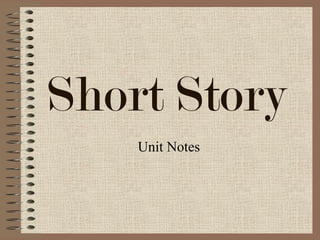
Storyanalysis
- 2. Short Stories • The short story emerged in the nineteenth century as a new, distinct literary form. • A short story is a brief work of fiction. • Because they are brief, short stories must be carefully crafted in order to accomplish its purpose. • In most short stories, one main character faces a conflict that is worked out in the plot of the story.
- 3. Protagonists and Antagonists • Protagonist – The protagonist is the main character in a literary work. • Antagonist –The antagonist is the character or force in conflict with the protagonist.
- 4. Fiction • Fiction – Fiction is prose writing that tells of imaginary characters and events. • Some authors base their works from their imagination; others base their stories on actual events and add invented characters, dialogue and events.
- 5. Characterization The act of creating and developing a character… • Direct characterization - The author directly states the character’s traits. • Indirect characterization – The author provides personality traits, actions, and/or thoughts of the character. It is then up to the reader to decide what this says about who the character is. • The most effective indirect characterizations usually result from showing characters acting or speaking.
- 6. Types of Characters… • Round characters – These characters have many different traits. They have faults as well as virtues. • Flat characters- The reader sees only one side of this type of character. • Dynamic characters – These characters change and develop throughout the course of the story. • Static characters- These characters remain unchanged throughout the story.
- 7. Narration and Point of View… Who tells the story? • First person narrative- A character in the story tells the story. Readers see only what this character sees, hears what this character hears, and so on. It is up to the reader to decide whether or not the narrator is a reliable source.
- 8. Narration continued… • Third person narrative- The story is told from a voice outside the story. • An omniscient, or all-knowing narrator can tell the reader exactly what each character thinks and feels. • A limited third person narrator sees the world through one character’s eyes and reveals only that character’s thoughts and feelings.
- 9. Plot The sequence of events in a literary work… • Exposition – The part of the work that introduces the characters, the setting and the basic situation. • Rising action – The elements in the story that lead up to the climax.
- 10. More elements of plot… • Climax- This is the story’s highest point. At this point, the story is most suspenseful and interesting. This is the turning point of the story. • Falling action – This is made up of the events that follow the climax. At this point, conflicts are beginning to be resolved; there may still be complications.
- 11. The final element of plot… • Resolution – This is the point where all of the story’s problems are solved. • Any events that happen after the resolution make up the denouement.
- 12. Setting… • The setting is the time and place during which the action occurs. • Setting is often important in setting the atmosphere or mood of the work because we often associate particular settings with specific feelings.
- 13. Conflict The struggle between opposing forces… • External conflict – This is a conflict between the main character and an outside force. • Man vs. Man • Man vs. Society • Man vs. Nature
- 14. More about conflict… • Internal conflict – The character is in conflict with himself of herself. This is usually a struggle to overcome a feeling or belief the character holds. • Man vs. Self • It is possible for a work to have more than one type of conflict.
- 15. Irony The difference between appearance and reality… • Dramatic irony – In this situation, there is a contradiction between what the character thinks and what the reader knows to be true. • Situational irony – An event takes place that contradicts the expectations of the characters, the audience and the readers. • Verbal irony – Words are used to suggest the opposite of what is meant.
- 16. Foreshadowing Hints about what’s to come… • Foreshadowing is the use of clues in a literary work that suggest of events that have yet to occur. • Foreshadowing helps create suspense by keeping readers wondering what will happen next.
- 17. Mood and Tone • Mood – The feeling the reader gets while reading a work. This feeling is created by the writer’s choice of words, events that occur in the work, or by the setting. • Tone – This is the writer’s attitude toward the reader and the subject. The tone can be formal or informal, friendly or distant, personal or impersonal.
- 18. Symbols What does this represent? • A symbol is anything that stands for or represents something else. • Some symbols are widely known and accepted (flags, signs, etc.) • Other symbols are unique to the particular work in which they appear.
- 19. Allegory • An allegory is a story with more than one level of meaning. • These stories can be read on the literal level based on the events. • They can also be read on a symbolic level in which the author is making a statement about ideas or beliefs. These stories are written to make a point (moral, political, religious).
- 20. Theme What is the purpose of this work? • The theme is the central idea, concern or purpose of a literary work. • The theme is the insight the author wants to pass along to the reader. • The theme is usually stated indirectly. It is up to the reader to decide what message the author is trying to send.
- 21. The End! • Sorry about your hand!